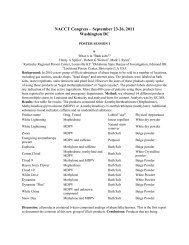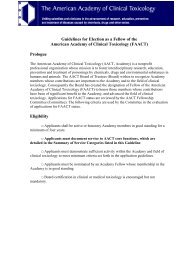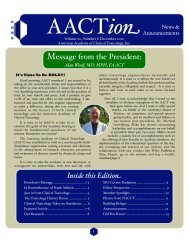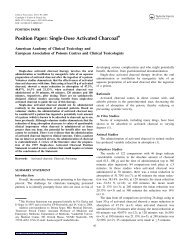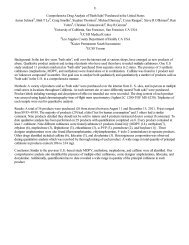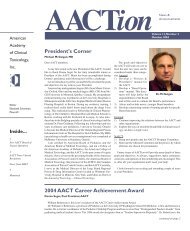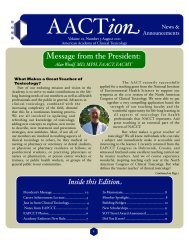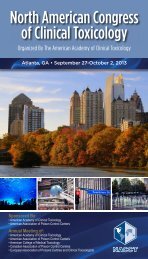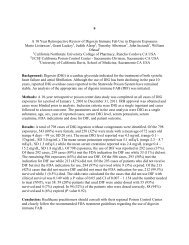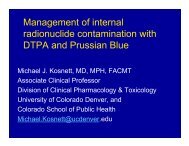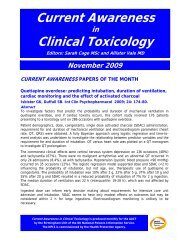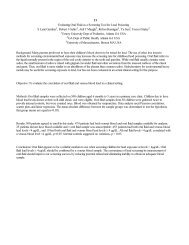Posters IV - The American Academy of Clinical Toxicology
Posters IV - The American Academy of Clinical Toxicology
Posters IV - The American Academy of Clinical Toxicology
Create successful ePaper yourself
Turn your PDF publications into a flip-book with our unique Google optimized e-Paper software.
submission. While this is below the expected volume <strong>of</strong> reportable cases, it illustrates the potential <strong>of</strong><br />
poison centers to contribute to medication safety reporting. Conclusions: Limitations include the need for<br />
staff re-education and the time required <strong>of</strong> clinical staff to review cases. Case submission is not a factor,<br />
as this is accomplished electronically by a poison information provider. To address these deficiencies,<br />
pharmacy students completing their experiential rotation in toxicology / drug information are now being<br />
utilized to review cases and will reduce the time burden on clinical staff. Additionally, brief re-education<br />
sessions at several monthly staff meetings throughout the year will improve the overall number and<br />
appropriateness <strong>of</strong> cases flagged for Medwatch® by SPIs.<br />
256<br />
Use <strong>of</strong> Robotic Telepresence for Poison Center Based Medical <strong>Toxicology</strong> Consultations: TeleToxTM<br />
A C Bronstein 1 , P Huang 2 , S Banerji 1 , A Gilbreath 2 , T Whitmore 2<br />
1 Rocky Mountain Poison & Drug Center-Denver Health, Denver CO USA<br />
2 Saint Alphonsus Regional Medical Center, Boise ID USA<br />
Background: Regional Poison Centers (PCs) routinely provide hospital and telephonic medical<br />
toxicology consultation. Although telephonic consults are limited to voice, hospitals can fax/email test<br />
results, and substance/clinical pictures on request. However, this process does not match bedside<br />
consultation. To improve on this provision <strong>of</strong> care, we piloted toxicology consultation via remote presence<br />
robots at a metropolitan and rural hospital system: TeleTox TM . Methods: We partnered with an 8 hospital<br />
telehealth network (metropolitan hub and 7 rural hospitals; bed range 10 - 361) serving one state using<br />
either RP-7 or RP-Lite telepresence robots (InTouch Health, Santa Barbara, CA) to converse with hospital<br />
emergency departments and critical care units. Training with the robots was conducted for all participating<br />
medical toxicology fellows and attendings. RP-7 Robots with 30 frame/second video for real-time motion<br />
capture can sense obstacles and move under manual video control to safely gain clear patient access. An<br />
initial robot laptop base station was replaced with a hardwired, encrypted desktop and T1 line in the PC.<br />
Consultations were initiated by the patient's hospital by contacting the hub-hospital's Access Center,<br />
which then contacted the toxicologist using the PC 800-number. Special patient consent was not required<br />
as no video recording was made. Initially Access Center personnel drove the robots as directed by the<br />
consulting toxicologist, and were available to coordinate transport if necessary. Headphones were<br />
available for both the toxicologist and SPI. Consult notes were entered into the PC case management<br />
system. <strong>The</strong> treating health care provider remained in charge <strong>of</strong> the patient's care with the toxicologist<br />
making recommendations as usual. Initially, TeleTox TM consults were available 9 am - 5 pm Monday –<br />
Friday. Results: A series <strong>of</strong> 2 mock cases was conducted with each toxicologist and ED staff from<br />
participating hospitals. Toxicologists also "beamed" in to 8 staff meetings to meet the remote ED<br />
physicians and staff. TeleTox TM went live on 14 February 2011. A total <strong>of</strong> 2 consultations have been done.<br />
TeleTox TM consult length appears longer than similar telephone consultations. Data continues to be<br />
accumulated. All TeleTox TM patients survived. Conclusions: Robotic toxicology telepresence<br />
(TeleTox TM ) is a promising PC application. Teletox TM has been well accepted by PC staff, physicians, and<br />
patients. Expansion to SPI follow-up calls and extended consultation hours with individual laptop systems<br />
outside the PC is possible. TeleTox TM may also have applicability for cross-town PC consultation with<br />
multiple hospitals or during public health events.<br />
257



